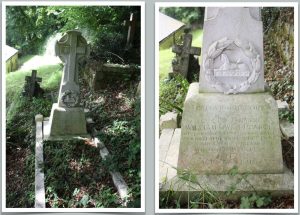3rd Battalion, Gloucestershire Regiment

William Owen Pearce was one of nine children born to Thomas and Mary (formerly Davies).
Thomas was born in Weston Super Mare and Mary in Llangoedmor, a village outside Cardigan. I have been unable to confirm a baptism but William was likely to have been born in 1878/79.
At the 1881 Census, the family were living in Bristol St George. Thomas 33 was a potter. Seven children are listed, the oldest Eliza having been born in Birmingham, one in Weston Super Mare, one in Bristol and the four youngest, including William in Wales.
By the time of the 1891 Census, the family were living in Weston Super Mare and Thomas was a potter at a brickyard and Margaret, a laundress. William, now 13, was a farm labourer. Living with the family was three-year-old Herbert F Vale, listed as ‘illegitimate child’ born in Exeter.
I have been unable to find William in the 1901 Census. His parents were shown as living in Bridgwater with 12-year-old Fred. Thomas stated that of their nine children, only three were still living. They had been married 32 years.
William next appears in the 1911 Census at Verdala Barracks Malta. He was 33, single and a sergeant with the 2nd Battalion Gloucestershire Regiment. He gave his former occupation as servant and his birth place as Blanwen-Fach, Cardigan.
It is likely that William was already a soldier at the 1901 Census.
The 2nd Battalion arrived in Cape Town between 27 January and 16 March 1900. They were involved with the garrison of Bloemfontein and remained in the Cape until 1904.
Unfortunately, no service records survive for William’s time during WW1. There are pension record cards and an entry in the register of soldier’s effects.
In the absence of service records, the following is a probable summary of Pearce’s service based on conjectures by Graham Adams.
He was undoubtedly a former regular army soldier with the Glosters. His number, 4920 indicates that he most likely enlisted in either late 1896 or early 1897 – when he would have been 18/19. He was almost certainly posted to the 2nd Battalion and was in South Africa at the time of the 1901 UK Census.
It would appear that he was serving beyond 1911, in which case he may have extended his commitment beyond the usual 12 years and had left the Army prior to the start of the Great War and was either recalled from the Reserve or volunteered his services.
No doubt, as a senior NCO with many years’ service he would have invaluable in the training of the new recruits. He may well have been posted to either the 1/4th or 2/4th Battalion, which were comprised of Territorials.
His Medal Roll entry (as distinct from the Medal Rolls Index Card (MRIC)) shows he was a member of the Glosters, attached to the King’s African Rifles (KAR).
His MRIC does state that his first posting abroad was to Africa on 17 November 1915 and it would appear that it was probably to provide some experience and leadership to colonial troops and he was sent on attachment to the KAR.
The reference to the West African Frontier Force in Northern Nigeria appears on the private family headstone but is not mentioned in the CWGC Register, which gives his unit as the 3rd Battalion. It is known that the 3rd Battalion was a Reserve battalion and it is common for men to be posted there after leaving their battalion ‘in the field’. Soldiers Died in the Great War shows him with the 3rd Battalion.
It is believed that units of the KAR did engage with the Germans in what was the German colony of Cameroon, situated in West Africa and occupying part of Northern Nigeria. Possibly William fought with the WAFF, rather than was posted to it and that his family believed that the reference to it would look good on his headstone.
There are two Register of Soldier’s Effects entries. One states that William served with the 7th Battalion Gloucestershire Regiment (but could have been the 4th Battalion, which is more likely, as the 7th served the majority of the war in Gallipoli and Mesopotamia) and died at Victoria Hospital in Swindon.
Payments of £19 10s and £23 9s 11d were made to his widow, Annie Eliza. The second states that William died of illness and a further payment of £55 was authorised.
There are also two entries in the pension card ledgers. One just gives his name number and rank of CSM. The other states that William died on 15 June 1917 from epilepsy aggravated by active service.
His widow was Annie Eliza Davis – date of birth 27 August 1883 – of the Star Inn, Slad.
She was awarded a pension of 16s 3d with effect from 7 January 1918. Sadly, William had only married Annie Eliza Davis Durn 13 days earlier at Slad church on 2 June 1917.
The marriage register stated that 38-year-old William was a soldier and the Annie was 33. Both of their addresses were given as the Star Inn Slad.
Annie was from a Stroud family but it’s not known how William came to be in Stroud.
William was buried at Slad church on 20 June 1917. His headstone states that he was a Sergeant of the Gloucestershire Regiment and West African Frontier Force, Northern Nigeria.
Sadly the cross including the Gloucestershire Regiment badge has been removed from the grave, possibly due to frost damage. A picture of the grave as at 29 September 2024 is shown below.
An extended description states that he was the son of Thomas Pearce of the Star Inn, Slad and husband of Annie Eliza Davis Pearce nee Durn. At the time of his death, he had been married for 13 days.
Annie re-married on 9 August 1920 at Slad church. Her husband was Fred George Kerry, a shunter with Great Western Railway.
Fred and his brothers Percival and Charles had all served in the war.
Annie died in 1937 and is buried in Slad.
Research by Helen Wollington (with additional information from Graham Adams) January 2021 and further update about the grave on 29 September 2024

The grave of William Owen Pearce with the cross removed as at 29/9/2024
